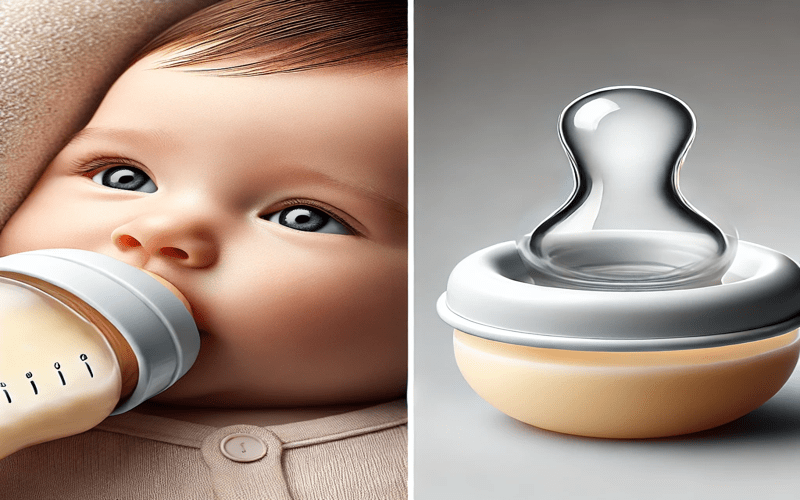
1.Introduction
Choosing the right bottle nipple is important for a smooth and comfortable feeding experience. Many parents wonder, what flow nipple for newborn is best? The answer is simple—newborns need a slow-flow nipple to control milk intake, prevent choking, and reduce gas or spit-up. A nipple with the right flow helps babies feed at a natural pace, just like breastfeeding. In this guide, we’ll explain nipple flow levels, signs that your baby may need a different flow, and the best slow-flow nipples for newborns.
2. Understanding Nipple Flow Levels: What Flow Nipple for Newborn is Best?
Choosing the right nipple flow is essential for newborns to have a smooth and comfortable feeding experience. Many parents wonder, what flow nipple for newborn is best? The flow level controls how quickly milk or formula comes out of the bottle, directly affecting your baby’s ability to feed properly. Selecting the right nipple flow for newborns helps prevent choking, gas, and discomfort, making feeding easier and more natural.
What Is Nipple Flow in Baby Bottles?
Nipple flow refers to the speed at which liquid passes through the bottle nipple.
It is designed to match a baby’s sucking strength and feeding development.
Selecting the right nipple flow is crucial for newborns, preventing issues like choking, gas, and colic. Many parents ask, what flow nipple for newborn is best? A slow-flow nipple ensures safe and comfortable feeding.
Different Nipple Flow Levels Explained
Most baby bottle brands categorize nipples into three main flow levels:
Slow Flow (Best for Newborns)
Mimics the natural breastfeeding pace.
Helps newborns control milk intake and prevents choking.
Reduces the risk of overfeeding, spit-up, and gas.
Ideal for babies learning to suck and swallow efficiently.
Medium Flow (For Babies 3+ Months)
Designed for babies with stronger sucking ability.
Allows slightly more milk to pass through without overwhelming the baby.
Suitable for transitioning between slow and fast flow.
Fast Flow (For Babies 6+ Months)
Best for older babies who can handle a higher milk flow.
Helps satisfy increased hunger needs.
Not recommended for newborns, as it may lead to choking or milk refusal.
Why Are Slow-Flow Nipples Recommended for Newborns?
When wondering what flow nipple for newborn is best, slow-flow nipples are usually the safest choice because:
They replicate the natural breastfeeding experience, making bottle-feeding easier for breastfed babies.
They prevent excessive milk intake, reducing the risk of gas, colic, and spit-up.
They support proper oral development, allowing newborns to suck and swallow at a natural rhythm.
By understanding these nipple flow levels, parents can confidently choose the best option for their newborn, ensuring a stress-free and enjoyable feeding experience.
What Flow Nipple is Best for Newborns?
One common question parents ask is, what flow nipple for newborn is best? The answer is simple—newborns need a slow-flow nipple to regulate milk intake, prevent choking, and support natural feeding. Trusted brands like Naturally, Tariqa, and SA offer high-quality slow-flow nipples designed to ensure a comfortable and safe feeding experience for your baby.
Why Do Newborns Need a Slow-Flow Nipple?
A gentle-flow nipple (also known as a low-flow nipple) is ideal for newborns because:
It mimics breastfeeding, allowing babies to feed at a natural pace.
It prevents milk from flowing too quickly, reducing the risk of choking and spit-up.
It helps with digestion, as babies can suck, swallow, and breathe properly.
If the flow is too fast, a newborn may struggle, leading to discomfort, gas, or bottle refusal. Wondering what flow nipple for newborn is best? Naturally offers slow-flow nipples designed for a safe and comfortable feeding experience.
How Different Brands Label Slow-Flow Nipples
Not all brands use the same labeling system for low-flow bottle nipples. While they serve the same purpose, their names may vary:
Preemie Flow – The slowest flow, designed for premature or very young babies.
Level 0 – Ultra-slow flow, often recommended for preemies or newborns struggling with feeding.
Level 1 – Standard slow-flow nipple, most commonly used for full-term newborns.
Stage 1 – Some brands use “Stage” instead of “Level,” but it means the same thing.
What flow nipple for newborn is best? When selecting a newborn bottle nipple flow, always check the brand’s labeling to ensure you’re choosing the slowest option. Naturally offers trusted slow-flow nipples designed for safe and comfortable feeding.
Can You Switch Nipple Flow Too Soon?
Many parents wonder when to transition to a moderate-flow nipple (also called medium-flow). However, switching too soon can cause:
Overfeeding, leading to stomach discomfort.
Increased gas and reflux, making feeding time stressful.
Choking or milk dribbling, as babies struggle to control the faster flow.
For the first few months, it’s best to stick with a gentle-flow nipple to ensure your baby feeds comfortably.
4. Signs Your Newborn Needs a Different Nipple Flow
Choosing the right feeding nipple flow is essential for a comfortable and stress-free feeding experience. But how do you know if your baby is struggling with the current nipple flow? Watching for key signs can help you determine whether it’s time to adjust the baby bottle nipple speed. If you’re wondering, what flow nipple for newborn is best, trusted brands like Naturally offer high-quality slow-flow nipples to support your baby’s natural feeding needs.
Signs the Nipple Flow is Too Slow
If the milk release rate is too slow, your newborn may become frustrated while feeding. Look for these signs:
Excessive sucking effort – Your baby is sucking too hard but getting little milk.
Long feeding sessions – A bottle takes much longer to finish than expected.
Baby falling asleep mid-feed – Struggling to get enough milk can make feeding exhausting.
Frustration or crying while feeding – Your baby may get irritated, latch and unlatch repeatedly, or refuse the bottle altogether.
Selecting the right slow-flow nipple ensures a comfortable and natural feeding experience for your newborn. With so many options available, choosing a trusted baby bottle nipple can help reduce gas, prevent choking, and support feeding development. Wondering what flow nipple for newborn is best? Naturally offers high-quality slow-flow nipples designed for a gentle and controlled milk flow.
Signs the Nipple Flow is Too Fast
If the milk flow is too high, your baby may struggle, causing discomfort. Wondering what flow nipple for newborn is best? Naturally offers slow-flow nipples for a controlled, comfortable feed. Watch for these warning signs!
Gagging or choking – Milk comes out too fast, making it hard for your baby to swallow properly.
Milk leaking from the mouth – If liquid dribbles out frequently, the slow-drip nipple may be too fast.
Increased gas or spit-up – A rapid-flow nipple can cause a baby to swallow too much air, leading to colic symptoms.
Coughing or heavy breathing during feeds – This can indicate that the feeding pace is too quick for your newborn to handle.
If your baby struggles with these issues, switching to a controlled-flow nipple with a slower release rate can help.
How to Test If the Nipple Flow is Right
To ensure you’re using the correct infant bottle nipple flow, try this simple test:
Hold the bottle upside down – Milk should drip slowly, not pour out.
Observe your baby’s reaction – Your baby should feed calmly without signs of distress or frustration.
Check feeding time – A newborn should finish a bottle in about 15–20 minutes. Faster or slower than this may indicate a poorly matched nipple speed.
Understanding these signs and adjusting the milk flow nipple accordingly will help create a smoother, more enjoyable feeding experience for both you and your baby.
5. Best Slow-Flow Nipples for Newborns
Selecting the right slow-flow nipple ensures a comfortable and natural feeding experience for your newborn. With so many options available, choosing a trusted baby bottle nipple can help reduce gas, prevent choking, and support feeding development. Wondering what flow nipple for newborn is best? Naturally offers high-quality slow-flow nipples designed for a gentle and controlled milk flow.
Dr. Brown’s Natural Flow Level 1 Nipple
Why It’s Great:
Designed with anti-colic venting to reduce gas and spit-up.
Mimics breastfeeding with a slow, steady flow.
Made from soft, high-quality silicone for a comfortable latch.
Dr. Brown’s is a top choice for parents wondering what flow nipple for newborn is best, especially for babies prone to colic or reflux.
2. Philips Avent Natural Response Nipple (Size 1)
Why It’s Great:
Breast-like shape for easy transition between bottle and breastfeeding.
Anti-collapse design supports natural sucking motions.
Slow-drip technology prevents overfeeding.
This newborn bottle nipple is ideal for babies switching between breast and bottle feeding.
3. Comotomo Slow-Flow Nipple
Why It’s Great:
Ultra-soft, flexible silicone mimics a mother’s breast.
Features dual anti-colic vents to prevent air intake.
Wide-base design makes it easy for babies to latch.
Comotomo’s gentle-flow nipple is a fantastic choice for newborns who prefer a more natural feel while bottle feeding.
4. Tommee Tippee Closer to Nature Slow-Flow Nipple
Why It’s Great:
Super-soft silicone feels natural in the baby’s mouth.
Slow-flow rate controls milk intake for newborns.
Flexible nipple movement mimics breastfeeding.
For parents seeking a controlled-flow nipple, Tommee Tepee’s design encourages a smooth transition from breast to bottle.
5. MAM Start Newborn Slow-Flow Nipple
Why It’s Great:
Symmetrical shape fits easily in a newborn’s mouth.
Ventilation system reduces gas and discomfort.
Extra-soft texture for gentle feeding.
MAM’s low-flow bottle nipple is great for preventing colic while ensuring a steady milk release.
Which Slow-Flow Nipple is Best for Your Newborn?
When selecting what flow nipple for newborn is ideal, consider your baby’s feeding style. A soft, slow-drip nipple with anti-colic features will make bottle feeding more comfortable. By choosing the right feeding nipple flow, you can ensure a stress-free and enjoyable feeding experience for both you and your baby.
Best Baby Carriers for Newborns – Comfort & Safety Guide
Conclusion
Choosing what flow nipple for newborn is best requires careful observation. A simple way to test is by holding the bottle upside down—milk should drip slowly, not pour out. If the flow is too slow, your baby may suck too hard, get frustrated, or take too long to finish a bottle. If it’s too fast, your baby might gag, choke, or have excessive milk leakage. Ideally, feeding should be smooth, taking about 15–20 minutes per bottle.
FAQs
1.What Age Is Flow 2 Nipple For?
Flow 2 nipples are generally designed for babies 3 months and older. At this stage, babies develop stronger sucking skills and need a slightly faster milk flow. However, every baby is different—some may still prefer a slow-flow nipple beyond 3 months.
2.What Is the Difference Between Flow 1 and Flow 2 Nipples?
Flow 1 nipples (slow-flow) are designed for newborns and infants learning to coordinate sucking, swallowing, and breathing. Flow 2 nipples (medium-flow) allow more milk to pass through, making feeding quicker for older babies who can handle a faster pace.
3.When to Move Baby to a Faster Flow Nipple?
Signs that your baby is ready for a faster flow include:
.Taking too long to finish a bottle (more than 30 minutes)
.Sucking too hard, collapsing the nipple
.Showing frustration during feeds
.Falling asleep before finishing a full bottle
4.What Flow Teat for Breastfed Baby?
Breastfed babies typically do best with slow-flow nipples (Level 1 or Preemie Flow) because they mimic the natural flow of breastfeeding. A slow-flow teat helps babies maintain proper sucking strength and prevents nipple confusion when switching between breast and bottle.
